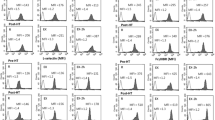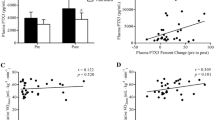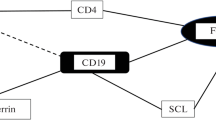Abstract
The chemiluminescence response of granulocytes to serum opsonized zymosan particles (SOZ) ex vivo was investigated during two ranger training courses lasting 7 days with continuous moderate physical activities corresponding to about 32% of maximal oxygen uptake or 35 000 kJ · 24 h−1, with energy deficiency (energy supply 0-4000 kJ · 24 h−1), and less than 3-h sleep during the 7 days. Significant granulocytosis in combination with a lymphopenia in peripheral blood was observed during the whole course. A priming of the granulocytes for accentuated chemiluminescence response to SOZ was observed during the first days of the course with a maximal increase on day 3 in course A (+35% of control response) and on day 1 in course B (+ 12%). Thereafter, reduced responses to SOZ compared to control values (−28% and −21% in course A and B) were observed. In course A, a group (n = 8) receiving 5000 kJ · 24 h−1 of additional energy, showed a more pronounced priming (maximum +57% versus +21 % of control response) during the first days. In course B, all the cadets had 3 h of organised rest/sleep on day 5, and a second priming of the chemiluminescence response was observed on the subsequent 2 days. These data indicated that moderate, continuous, predominantly aerobic physical activities for 1–3 days around the clock primed the production of reactive oxygen species in granulocytes. This priming may be beneficial for, for example, host defence against micro-organisms, but may also contribute to inflammatory damage to normal tissues such as muscle, tendons and joints during exercise. However, when the moderate exercise continued for several more days, a down-modulation of the granulocyte response was observed. The findings of this study further support the possibility that moderate physical activity stimulates immunity, while more extreme duration of the same activities may result in a down-modulation of nonspecific (and specific) immunity.
Similar content being viewed by others
References
Al-Mohanna FA, Haller MB (1992) Mechanisms of oxidase activation in neutrophils.In: Harris JR (ed) Blood cell biochemistry, 3. Lymphocytes and granulocytes. Plenum Press, New York, pp 289–334
Armstrong RB, Warren GL, Warren JA (1991) Mechanisms of exercise-induced muscle fibre injury. Sports Med 12:184–207
Babior BM (1984) Oxidants from phagocytes: agents of defence and destruction. Blood 64:959–966
Bernton E, Galloway R, Hoover D (1994). Immune function II: monocyte and granulocyte function. Nutritional and imunological assessment of ranger students with increased caloric intake, chapter 10, Report No T95-5. US Army Research Institute of Environmental Medicine, Natick, Mass.
Bishop CR, Athens JW, Boggs DR, Warner HR, Cartwright GE, Wintrobe MM (1968) Leukokinetic studies. XIII. A non-steadystate kinetic evaluation of the mechanism of cortisone-induced granulocytosis. J Clin Invest 47:249–260
Bosenberg AT, Brock-Utne JG, Gaffin SL, Wells B, Blake TW (1988) Strenuous exercise causes systemic endotoxemia. J Appl Physiol 65:106–108
Bøyum A (1968) Isolation of mononuclear cells and granulocytes from human blood. Scand J Clin Invest 21 [Suppl 97]:77–89
Bøyum A, Wiik P, Gustavsson E, Veiby OP, Reseland J, Haugen A-H, Opstad PK (1996) The effect of strenuous exercise, calorie deficiency and sleep deprivation on white blood cells, plasma immunoglobulins and cytokines. Scand J Immunol 43:228–235
Broch-Utne JG, Gaffin SL, Wells MT, Gathiram P, Sohar E, James ME, Morrell DF, Norman RJ (1988) Endotoxinemia in exhausted runners after a long-distance race. S Aft Med J 73:533–536
Dahlgren C, Follin F, Johanson A, Lock R, Lundqvist H, Walan Å (1991) Chemiluminescence as a means of following the function of phagocytic cells. Trends Photochem Photobiol 2:427–443
Fitzgerald L (1988) Exercise and the immune system. Immunol Today 9:337–339
Foster LB, Dunn RT (1974) Single-antibody technique for radioimmunoassay of cortisol in unextracted serum or plasma. Clin Chem 20:365–368
Fuchs D, Malkovsky M, Reibnegger G, Werner ER, Forni G, Wachter H (1990) Endogenous release of interferon-gamma and diminished response of peripheral blood mononuclear cells to antigenic stimulation. Immunol Lett 23:103–108
Gabriel H, Urhausen A, Kindermann W (1992) Mobilization of circulating leukocyte and lymphocyte subpopulations during and after short, anaerobic exercise. Eur J Appl Physiol 65:164–170
Ganong WF (1991) Circulating body fluids.In: Ganong (ed) Review of medical physiology. Appleton and Lange, Colo., USA, pp 479–483
Gibson-Berry KL, Whitin JC, Cohen HJ (1993) Modulation of the respiratory burst in human neutrophils by isoproterenol and dibutyryl cyclic AMP. J Neuroimmunol 43:59–68
Gray AB, Telford RD, Collins M, Baker MS, Weidemann MJ (1993) Granulocyte activation induced by intense interval running. J Leukocyte Biol 53:591–597
Green RJ, Kaplan SS, Rabin BS, Stanitski CL, Zdziarski U (1981) Immune function in the marathon runner. Ann Allergy 47:73–75
Hack V, Strobel G, Rau JP, Weicker H (1992) The effect of maximal exercise on the activity of neutrophil granulocytes. Eur J Appl Physiol 65:520–524
Heijnen CJ, Kavelaars A, Ballieux RY (1991) Corticotropin-releasing hormone and pro opiomelanocortin-derived peptides in the modulation of immune function.In: Ader R, Felten DL, Cohen N (eds) Psychoneuroimmunology. Academic Press, New York, pp 429–444
Hoffman-Goetz L, Pedersen B K (1994) Exercise and the immune system: a model of the stress response? Immunol Today 8:382–387
Huizinga TWJ, de Haas M, Kleijer M, Nuijens JH, Roos D, von der Borne A (1990) Soluble Fcγ receptor III in human plasma originates from release by neutrophils. J Clin Invest 86:416–423
Keast D, Kameron K, Morton AR (1988) Exercise and the immune response. Sports Med 5:248–267
Khansari DN, Murgo AJ, Faith RE (1990) Effects of stress on the immune system. Immunol Today 11:170–175
Kiecolt-Glaser JK, Glaser R (1991) Stress and immune function in humans.In: Ader R, Felten DL, Cohen N (eds) Psychoneuroimmunology. Academic Press, New York, pp 849–864.
Kokot K, Schaefer RM, Teschner M, Gilge U, Plass R, Heidland A (1988) Activation of leukocytes during prolonged physical exercise. Adv Exp Med Biol 240:57–63
Kramer T (1994) Immune function I: lymphocyte proliferation & subset analysis; interleukin production. Nutritional and immunological assessment of ranger students with increased caloric intake, chapter 9, Report No T95-5. US Army Research Institute of Environmental Medicine, Natick, Mass.
Lewicki R, Tchórzewski H, Denys A, Kowalska M, Golinska A (1987) Effects of physical exercise on some parameters of immunity in conditioned sportsmen. Int J Sports Med 8:309–314
Loeper M, Crouzon O (1904) L'action de l'adrénalin sur le sang. Arch Med Exp Anat Pathol 18:83–108
Malec P, Tchórzewski H, Markiewicz K, Zeman K, Baj Z, Nowak Z, Pokoca L (1989) Some mechanisms of immunosuppressive action of epinephrine in humans. Allergol Immunopathol 117:81–84
McGillis JP, Mitsuhashi M, Payan DG (1991) Immunological properties of substance P.In: Ader R, Felten DL, Cohen N (eds) Psychoneuroimmunology. Academic Press, New York, pp 209–220
Øktedalen O, Lunde OC, Opstad PK, Aabakken L, Kvernebo K (1992) Changes in the gastrointestinal mucosa after long-distance running. Scand J Gastroenterol 27:270–274
Opstad PK (1990) Adrenergic desensitization and alterations in free and conjugated catecholamines during prolonged strain, sleep and energy deficiency. Biogen Amines 7:625–639
Opstad PK (1991) Alterations in the morning plasma levels of hormones and the endocrine responses to bicycle exercise during prolonged strain. The significance of energy and sleep deprivation. Acta Endocrinol 125:14–22
Ottaway CA (1991) Vasoactive intestinal peptide and immune function.In: Ader R, Felten DL, Cohen N (eds) Psychoneuroimmunology. Academic Press, New York, pp 225–256
Sharp NC, Koutedakis Y (1992) Sport and the overtraining syndrome: Immunological aspects. Br Med Bull 48:518–533
Smith JA, Telford RD, Mason IB, Weidemann MJ (1990) Exercise, training and neutrophil microbicidal activity. Int J Sports Med 11:179–187
Tilz GP, Domej W, Diez-Ruiz A, Weiss G, Brezinschek R, Brezinschek HP, Hüttl E, Pristautz H, Wachter H, Fuchs D (1993) Increased immune activation during and after physical exercise. Immunobiology 188:194–202
Weicker H, Werle E (1991) Interaction between hormones and the immune system. Int J Sports Med 12 [Suppl 1]:S30-S37
Wiik P (1989) Vasoactive intestinal peptide inhibits the respiratory burst in human monocytes by a cyclic AMP-mediated mechanism. Regul Pept 25:187–197
Wiik P, Skrede KK, Knardahl S, Haugen A-H, Ærø CE, Opstad PK, Boyum A (1995) Effect of in vivo corticosterone and acute food deprivation on rat resident peritoneal cell chemiluminescence after activation ex vivo. Acta Physiol Scand 154:407–416
Author information
Authors and Affiliations
Rights and permissions
About this article
Cite this article
Wiik, P., Opstad, P.K. & Bøyum, A. Granulocyte chemiluminescence response to serum opsonized zymosan particlesex vivo during long-term strenuous exercise, energy and sleep deprivation in humans. Europ. J. Appl. Physiol. 73, 251–258 (1996). https://doi.org/10.1007/BF02425484
Accepted:
Issue Date:
DOI: https://doi.org/10.1007/BF02425484




